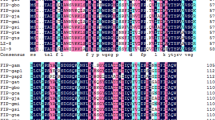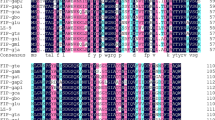Abstract
Fungal immunomodulatory proteins (FIPs) have been identified from a series of fungi, especially in Ganoderma species. However, little is known about the FIPs from G. applanatum. In this study, two novel FIP genes, termed as FIP-gap1 and FIP-gap2, were cloned from G. applanatum, characterized and functionally expressed after codon optimization in Pichia pastoris GS115. Results showed that FIP-gap1 and FIP-gap2 comprised 342-bp encoding peptides of 113 amino acids, which shared a high homology with other Ganoderma FIPs. The yield of recombinant FIP-gap1 and FIP-gap2 increased significantly after codon optimization and reached 247.4 and 197.5 mg/L, respectively. Bioactivity assay in vitro revealed that both rFIP-gap1 and rFIP-gap2 could agglutinate mouse, sheep, and human red blood cells. Besides, rFIP-gap1 and rFIP-gap2 obviously stimulated the proliferation of mouse splenocytes and enhanced IL-2 and IFN-γ release. Cytotoxicity detection indicated that IC50 of rFIP-gap1 towards A549 and HeLa cancer cells were 29.89 and 8.34 μg/mL, respectively, whereas IC50 of rFIP-gap2 to the same cancer cells were 60.92 and 41.05 μg/mL, respectively. Taken together, novel FIP gaps were cloned and functionally expressed in P. pastoris, which can serve as feasible and stable resources of rFIP gaps for further studies and potential applications.








Similar content being viewed by others
References
Bai JP, Swartz DJ, Protasevich II, Brouillette CG, Harrell PM, Hildebrandt E, Gasser B, Mattanovich D, Ward A, Chang G, Urbatsch IL (2011) A gene optimization strategy that enhances production of fully functional p-glycoprotein in Pichia pastoris. PLoS One 6(8):e22577
Bastiaan-Net S, Chanput W, Hertz A, Zwittink RD, Mes JJ, Wichers HJ (2013) Biochemical and functional characterization of recombinant fungal immunomodulatory proteins (rFIPs). Int Immunopharmacol 15:167–175
Behura SK, Severson DW (2013) Codon usage bias: causative factors, quantification methods and genome-wide patterns: with emphasis on insect genomes. Biol Rev Camb Philos Soc 88:49–61
Brandis G, Hughes D (2016) The selective advantage of synonymous codon usage bias in Salmonella. PLoS Genet 12:e1005926
Chang YC, Chow YH, Sun HL, Liu YF, Lee YT, Lue KH, Ko JL (2014) Alleviation of respiratory syncytial virus replication and inflammation by fungal immunomodulatory protein FIP-fve from Flammulina velutipes. Antivir Res 110:124–131
Chang YC, Hsiao YM, Hung SC, Chen YW, Ou CC, Chang WT (2015) Alleviation of Dermatophagoides microceras-induced allergy by an immunomodulatory protein, FIP-fve, from Flammulina velutipes in mice. Biosci Biotechnol Biochem 79:88–96
Cheng D, Huang XY, Li BJ (2002) A method for preparation of high quality DNA from medical fungi and construction of a genomic library. Mycosystema 21:137–139 (in Chinese)
Duan HK, Wang HS, Ma BC, Jiang PZ, Tu PP, Ni ZZ, Li XD, Li M, Ma XF, Wang B, Wu R, Li MG (2015) Codon optimization and expression of irisin in Pichia pastoris GS115. Int J Biol Macromol 79:21–26
González-Muñoz A, Botero-Orozco KJ, López-Gartner GA (2014) Finding of a novel fungal immunomodulatory protein coding sequence in Ganoderma australe. Rev Colomb Biotecnol 16(2):90–95
Hsin IL, Ou CC, Wu MF, Jan MS, Hsiao YM, Lin CH, Ko JL (2015) GMI, an immunomodulatory protein from Ganoderma microsporum, potentiates cisplatin-induced apoptosis via autophagy in lung cancer cells. Mol Pharm 12:1534–1543
Hsu HC, Hsu CI, Lin RH, Kao CL, Lin JY (1997) Fip-vvo, a new fungal immunomodulatory protein isolated from Volvariella volvacea. Biochem J 323:557–565
Kim JE, Park SJ, Yu MH, Lee SP (2014) Effect of Ganoderma applanatum mycelium extract on the inhibition of adipogenesis in 3T3-L1 adipocytes. J Med Food 17:1086–1094
Kino K, Yamashita A, Yamaoka K, Watanabe J, Tanaka S, Ko K, Shimizu K, Tsunoo H (1989) Isolation and characterization of a new immunomodulatory protein, Lingzhi-8 (LZ-8), from Ganoderma lucidum. J Biol Chem 264:472–478
Ko JL, Hsu CI, Lin RH, Jai CL, Lin JY (1995) A new fungal immunomodulatory protein, FIP-fve isolated from the edible mushroom, Flammulina velutipes and its complete amino acid sequence. Eur J Biochem 228:244–249
Lee YT, Wu CT, Sun HL, Ko JL, Lue KH (2017) Fungal immunomodulatory protein-fve could modulate airway remodel through by affect IL17 cytokine. J Microbiol Immunol Infect. https://doi.org/10.1016/j.jmii.2017.06.008
Li QZ, Wang XF, Chen YY, Lin J, Zhou XW (2010) Cytokines expression induced by Ganoderma sinensis fungal immunomodulatory proteins (FIP-gsi) in mouse spleen cells. Appl Biochem Biotechnol 162:1403–1413
Li QZ, Wang XF, Zhou XW (2011) Recent status and prospects of the fungal immunomodulatory protein family. Crit Rev Biotechnol 31:365–375
Li F, Wen H, Liu X, Zhou F, Chen G (2012) Gene cloning and recombinant expression of a novel fungal immunomodulatory protein from Trametes versicolor. Protein Expr Purif 82:339–344
Li SY, Shi LJ, Ding Y, Nie Y, Tang XM (2015) Identification and functional characterization of a novel fungal immunomodulatory protein from Postia placenta. Food Chem Toxicol 78:64–70
Li S, Zhao L, Xu W, Jiang Z, Kang J, Wang F, **n F (2016) Identification and characterization of a novel protein FIP-sch3 from Stachybotrys chartarum. PLoS One 11:e0168436
Li S, Jiang Z, Sun L, Liu X, Huang Y, Wang F, **n F (2017) Characterization of a new fungal immunomodulatory protein, FIP-dsq2 from Dichomitus squalens. J Biotechnol 246:45–51
Liao CH, Hsiao YM, Lin CH, Yeh CS, Wang JC, Ni CH, Hsu CP, Ko JL (2008) Induction of premature senescence in human lung cancer by fungal immunomodulatory protein from Ganoderma tsugaep. Food Chem Toxicol 46:1851–1859
Lin WH, Huang CH, Hsu CI, Lin JY (1997) Dimerization of the N-terminal amphipathic-helix domain of the fungal immunomodulatory protein from Ganoderma tsugae (Fip-gts) defined by a yeast two-hybrid system and site directed mutagenesis. J Biol Chem 272:20044–20048
Lin JW, Hao LX, Xu GX, Sun F, Gao F, Zhang R, Liu LX (2009) Molecular cloning and recombinant expression of a gene encoding a fungal immunomodulatory protein from Ganoderma lucidum in Pichia pastoris. World J Microbiol Biotechnol 25:383–390
Lin JW, Jia J, Shen YH, Zhong M, Chen LJ, Li HG, Ma H, Guo ZF, Qi MF, Liu LX, Li TL (2013) Functional expression of FIP-fve, a fungal immunomodulatory protein from the edible mushroom Flammulina velutipes in Pichia pastoris GS115. J Biotechnol 168:527–533
Lin HJ, Chang YS, Lin LH, Haung CF, Wu CY, Ou KL (2014) An immunomodulatory protein (Ling Zhi-8) from a Ganoderma lucidum induced acceleration of wound healing in rat liver tissues after monopolar electrosurgery. Evid Based Complement Alternat Med 2014:1–12. https://doi.org/10.1155/2014/916531
Lin JW, Guan SY, Duan ZW, Shen YH, Fan WL, Chen LJ, Zhang L, Zhang L, Li TL (2016) Gene cloning of a novel fungal immunomodulatory protein from Chroogomphis rutilus and its expression in Pichia pastoris. J Chem Technol Biotechnol 91:2761–2768
Lin TY, Hsu HY, Sun WH, Wu TH, Tsao SM (2017) Induction of Cbl-dependent epidermal growth factor receptor degradation in Ling Zhi-8 suppressed lung cancer. Int J Cancer 140:2596–2607
Liu ZH, Hou XG, Zhao JH, He L (2015) Liquid fermentation of Ganoderma applanatum and antioxidant activity of exopolysaccharides. Open Biomed Eng J 9:224–227
Lu Y, Fang C, Wang Q, Zhou Y, Zhang G, Ma Y (2017) Corrigendum: high-level expression of improved thermo-stable alkaline xylanase variant in Pichia pastoris through codon optimization, multiple gene insertion and high-density fermentation. Sci Rep 16:44719
Ma JQ, Liu CM, Qin ZH, Jiang JH, Sun YZ (2011) Ganoderma applanatum terpenes protect mouse liver against benzo (α) pyren-induced oxidative stress and inflammation. Environ Toxicol Pharmacol 31:460–468
Mao XL (2000) The macrofungi in China. Henan Science Express, Zhengzhou
Osińska-Jaroszuk M, Wlizło K, Szałapata K, Jarosz-Wilkołazka A (2014) Correlation between the production of exopolysaccharides and oxalic acid secretion by Ganoderma applanatum and Tyromyces palustris. World J Microbiol Biotechnol 30:3065–3074
Pushparajah V, Fatima A, Chong CH, Gambule TZ, Chan CJ, Ng ST, Tan CS, Fung SY, Lee SS, Tan NH, Lim RLH (2016) Characterisation of a new fungal immunomodulatory protein from Tiger milk mushroom, Lignosus rhinocerotis. Sci Rep 6:30010
Tran AM, Nguyen TT, Nguyen CT, Huynh-Thi XM, Nguyen CT, Trinh MT, Tran LT, Cartwright SP, Bill RM, Hieu TV (2017) Pichia pastoris versus Saccharomyces cerevisiae: a case study on the recombinant production of human granulocyte-macrophage colony-stimulating factor. BMC Res Notes 10:148
Wu MY, Hsu MF, Huang CS, Fu HY, Huang CT, Yang CS (2007) A 2.0 structure of GMI, a member of the fungal immunomodulatory protein family from Ganoderma microsporum. Protein Crystallogr II-132
**ang L, Wang QH, Zhou YL, Yin LF, Zhang GM, Ma YH (2016) High-level expression of a ZEN-detoxifying gene by codon optimization and biobrick in Pichia pastoris. Microbiol Res 193:48–56
Xu XF, Yan HD, Chen J, Zhang XW (2011) Bioactive proteins from mushrooms. Biotechnol Adv 29:667–674
Xu H, Kong YY, Chen X, Guo MY, Bai XH, Lu YJ, Li W, Zhou XW (2016) Recombinant FIP-gat, a fungal immunomodulatory protein from Ganoderma atrum, induces growth inhibition and cell death in breast cancer cells. J Agric Food Chem 64:2690–2698
Zhao JD, Zhang XQ (1992) Resources and distribution of Ganodermataceae in China. Acta Mycol Sin 11:55–62 (in Chinese)
Zhao X, Huo KK, Li YY (2000) Synonymous codon usage In Pichia pastoris. Sheng Wu Gong Cheng Xue Bao 16:308–311 (in Chinese)
Zhong HL, **ao GH, ** HZ, Le HE (2016) Retraction notice: liquid fermentation of Ganoderma applanatum and antioxidant activity of exopolysaccharides. Open Biomed Eng J 10:114
Zhou XW, **e MQ, Hong F, Li QZ, Lin J (2009) Genomic cloning and characterization of a FIP-gsi gene encoding a fungal immunomodulatory protein from Ganoderma sinense. Int J Medicinal Mushrooms 11:77–86
Acknowledgments
This work was supported mainly by a grant from National Natural Science Foundation of China (Grant No. 31000928) and also by two other grants from the Cultivation Plan for Youth Agricultural Science and Technology Innovative Talents of Liaoning Province (Grant No. 2015043) as well as Technology Pillar Program of Liaoning Province, China (Grant No. 2015103001).
Funding
This study was supported mainly by a grant from National Natural Science Foundation of China (31000928) and two other grants from the Cultivation Plan for Youth Agricultural Science and Technology Innovative Talents of Liaoning Province (2015043) as well as Technology Pillar Program of Liaoning Province (2015103001).
Author information
Authors and Affiliations
Corresponding authors
Ethics declarations
Conflict of interest
The authors declare that they have no conflict of interest.
Ethical approval
This article does not contain any studies with human participants or animals performed by any of the authors.
Electronic supplementary material
ESM 1
(PDF 1242 kb)
Rights and permissions
About this article
Cite this article
Zhou, S., Guan, S., Duan, Z. et al. Molecular cloning, codon-optimized gene expression, and bioactivity assessment of two novel fungal immunomodulatory proteins from Ganoderma applanatum in Pichia. Appl Microbiol Biotechnol 102, 5483–5494 (2018). https://doi.org/10.1007/s00253-018-9022-5
Received:
Revised:
Accepted:
Published:
Issue Date:
DOI: https://doi.org/10.1007/s00253-018-9022-5




